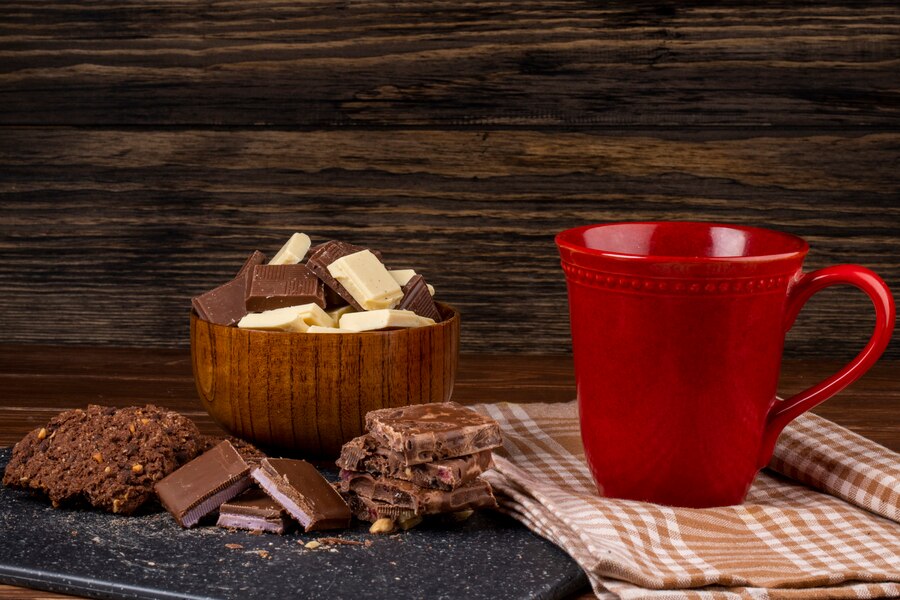Chocolate tea is a delightful and soothing beverage that offers more than just a sweet taste. Combining cocoa’s rich flavors with tea’s comforting properties, this beverage has grown in popularity due to its potential health benefits. Chocolate tea is often brewed with high-quality cocoa or chocolate-infused leaves, making it a great alternative to traditional teas or sugary drinks. We will explore the health benefits of chocolate tea, including its ability to improve mood, support heart health, and boost cognitive function, all while providing a comforting, indulgent experience.
Mood Enhancement and Stress Relief
One of the most notable benefits of chocolate tea is its ability to improve mood and relieve stress. Cocoa in chocolate tea stimulates the release of endorphins, the body’s natural feel-good chemicals. These endorphins help to create a sense of well-being and relaxation, which can reduce feelings of anxiety and stress. Additionally, cocoa contains compounds that promote the release of serotonin, a neurotransmitter responsible for stabilizing mood and promoting relaxation. Chocolate tea’s rich, indulgent flavor also has a psychological effect, providing comfort and warmth that can uplift the spirit, making it a great choice during stressful moments. Whether enjoyed in the morning to start the day or in the evening as a relaxing bedtime beverage, chocolate tea offers a soothing experience that can help manage mood swings and reduce stress.
Heart Health Support
Chocolate tea is not only a treat for the senses but also a potential ally in promoting heart health. The antioxidants in cocoa, particularly flavonoids, are significant in supporting cardiovascular health. These antioxidants help improve blood flow, reduce inflammation, and protect the heart from oxidative stress. Studies have shown that consuming moderate amounts of dark chocolate or cocoa-based products can help lower blood pressure and reduce the risk of heart disease. Drinking chocolate tea, with its infusion of cocoa, can provide a simple and enjoyable way to incorporate these heart-healthy antioxidants into your daily routine. Furthermore, the mild caffeine content in chocolate tea can provide an energy boost without the jitters often associated with stronger caffeinated drinks, making it a more heart-friendly alternative to coffee.
Cognitive Function and Mental Clarity
Another impressive benefit of chocolate tea is its potential to boost cognitive function and enhance mental clarity. The flavonoids in cocoa are believed to promote better blood flow to the brain, which can support overall cognitive performance. These compounds are linked to improved memory, focus, and concentration, making chocolate tea a great option for those looking to enhance their mental capabilities. Additionally, cocoa contains small amounts of caffeine, a natural stimulant that improves alertness and cognitive function. However, the caffeine content in chocolate tea is much lower than that of coffee, making it a gentler option for those who want to avoid the intense stimulation of stronger caffeinated beverages. By enjoying a cup of chocolate tea, individuals can give their brains a gentle boost, enhancing productivity and mental clarity.
Rich in Antioxidants and Nutrients
Chocolate tea offers a variety of essential nutrients and antioxidants that contribute to overall health and well-being. Cocoa, the main ingredient in chocolate tea, is rich in polyphenols, an antioxidant that helps fight free radicals in the body. Free radicals can cause oxidative stress linked to various chronic conditions, including inflammation, heart disease, and cancer. By consuming antioxidants through chocolate tea, individuals can support their body’s natural defenses against oxidative damage. Additionally, cocoa contains minerals such as magnesium, iron, and zinc, all of which play important roles in maintaining healthy bodily functions. Magnesium, for example, is essential for muscle function and bone health, while iron supports healthy blood circulation. By incorporating chocolate tea into your daily routine, you can enjoy a nutrient-packed beverage that nourishes both body and mind.
A Natural Energy Boost
Unlike traditional caffeinated beverages that often lead to a crash in energy levels, chocolate tea provides a natural and sustained energy boost. The combination of caffeine and theobromine, another stimulant found in cocoa, works synergistically to provide a mild, sustained increase in energy and alertness. Theobromine, in particular, is known for its stimulating effects on the central nervous system, promoting feelings of energy and vitality without the intense crash that often follows a cup of coffee or sugary energy drinks. This makes chocolate tea a perfect choice for those looking to maintain energy levels throughout the day without experiencing the jitters or irritability of stronger caffeinated drinks. Whether tackling a busy workday or needing a pick-me-up during an afternoon slump, chocolate tea provides a balanced energy boost that keeps you refreshed and focused.
Chocolate tea is much more than just a delicious treat—it offers a variety of health benefits that can enhance both physical and mental well-being. From mood enhancement and stress relief to heart health support and improved cognitive function, chocolate tea provides a range of benefits that make it a worthwhile addition to any diet. The antioxidants and essential nutrients in cocoa support overall health, while the natural energy boost and digestive benefits make it a great choice for daily consumption. Whether enjoyed for its comforting taste or its potential health benefits, chocolate tea is a sweet and soothing beverage that can be enjoyed by anyone looking to improve their overall health and well-being.










